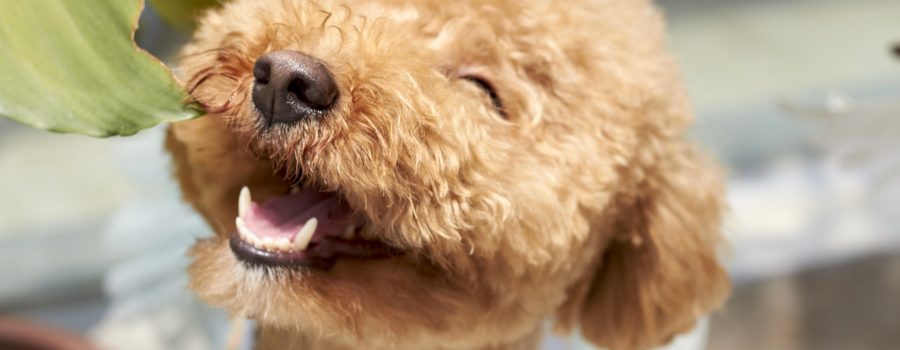Just like humans, dogs and cats need to have their teeth cleaned regularly to prevent serious periodontal disease from developing. Tooth and gum decay can lead to pain and infections in the teeth and gums. Although localized to the mouth, these chronic infections can affect vital organs like the heart, liver, and kidneys. Furthermore, pets will often remain asymptomatic through the early stages of periodontal disease and there is no good way to visually confirm whether or not your pet is suffering from problems beneath their gum line without seeing a veterinarian. All of this is to say that daily brushing (or, at the very least, brushing as often as possible) is vital to your pet’s long term wellbeing.
The prospect of brushing an animal’s teeth regularly—let alone daily—can feel like a monumental task. However, daily brushing is a goal you can achieve with your pet. In this article, we’ll walk through some of the tips and tricks we’ve seen clients use to acclimate their pets to the brushing process.
As always, the best advice comes from a veterinarian who can observe and learn about your pet’s unique disposition and behavior. Thus, the first phase in beginning a daily brushing routine should always be to see your veterinarian so that they can properly assess the current health of your pet’s teeth and gums. Additionally, we highly recommend asking your veterinarian to demonstrate proper brushing technique for you in person during this appointment.
How to Brush
Before you start brushing, make sure you have the proper equipment: the right size brush and toothpaste meant for animals. DO NOT use regular human toothpaste at any time to brush your pet’s teeth. Swallowed human-toothpaste can lead to stomach upset and could even be toxic. Make sure to buy a brush that is specifically made for the size and species of pet that you have—this will greatly improve the effectiveness of your brushing efforts. You’ll also want to get a toothpaste that tastes good to your pet. This aspect of the brushing journey can take some old fashioned trial and error to get right, and you may have to try multiple flavors before you find one that works best.
Once you have the proper tools, start by slowly introducing your pet to the brush and paste without actually brushing. Veterinarian Dr. Sheldon Rubin, in a video made for the American Veterinary Medical Association, tells his clients to spend about a week just letting their pet be near the brush and toothpaste. Give them the opportunity to smell and lick the paste while it’s on your finger; this may give you a sense for whether or not your pet finds the flavor of paste you’ve chosen to be pleasurable.
Next, you can put a little bit of the paste on their teeth with your finger and then give them a reward directly afterwards so that they associate the brush and paste with positive feedback. Again, repeat this step for a few days to a week. During this time you can also experiment with running your finger along your pet’s gums so that they begin to get comfortable with having you probe their mouth. As with all these steps, patience and consistency are going to be the two keys to success. Don’t get discouraged if it takes longer than a week for your pet to begin acclimating to any of these steps in the process.
Finally, put the toothpaste on the brush and let your dog or cat sit near it so that they know it isn’t a dangerous object.
Now, you’re ready to being brushing. The basic technique is to lift your pet’s lip up and brush in a circular motion with the brush at a 45° angle to the teeth with the bristles facing upwards towards the gums. The AVMA recommends starting with very short intervals—just a few seconds—followed by treats and praise to encourage your pet to stick with it. When it seems like your pet is getting used to the routine, you can begin to gradually increase the amount of time for each brush. Eventually, you’ll want to work up to a thorough brushing of the mouth in one sitting, but, again, this takes time.
We have also found that it’s best not to linger too long on any one spot. If the brushing takes an excessive amount of time your pet will understandably start to get either bored or uncomfortable. While brushing, you only need to worry about brushing the outside of your pet’s teeth. This is where most of the plaque buildup happens and reaching the inside of the teeth is tricky and may be unpleasant for your pet.
Getting in the habit takes some time, but once you put the effort in upfront, you’ll be able to establish a consistent routine that will become ordinary for both you and your pet. If you need a quick refresher on the consequences of poor dental hygiene, see our article on periodontal disease.
One final note: even pets whose owners brush their teeth will still likely require periodic cleanings with their veterinarian. Brushing regularly, however, will usually lead to quicker and easier veterinary cleanings. The difference in cost between a cleaning without extractions and a cleaning with them can be huge. Brushing will help save your pet from being in unnecessary pain, and your wallet from being unnecessarily burdened.
Was this article helpful? For more great insights on how to take the best care of your pet, check out our free pet care tips!
Click Here for Access




